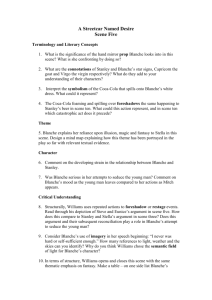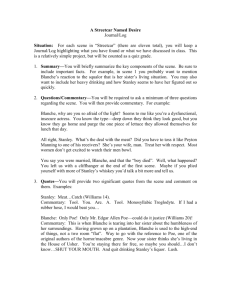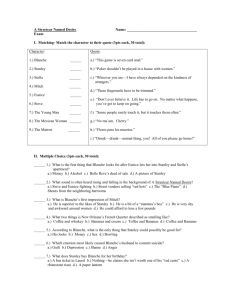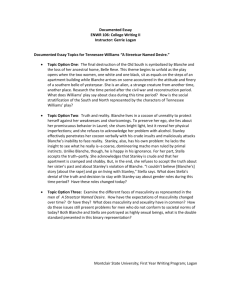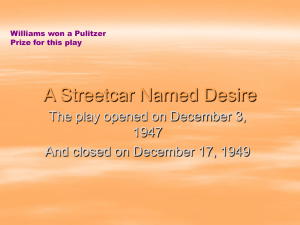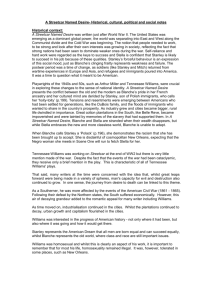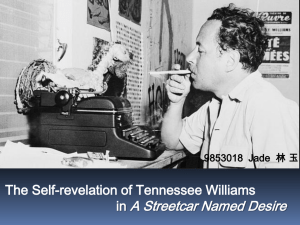study pack.doc - ibenglish2011
advertisement
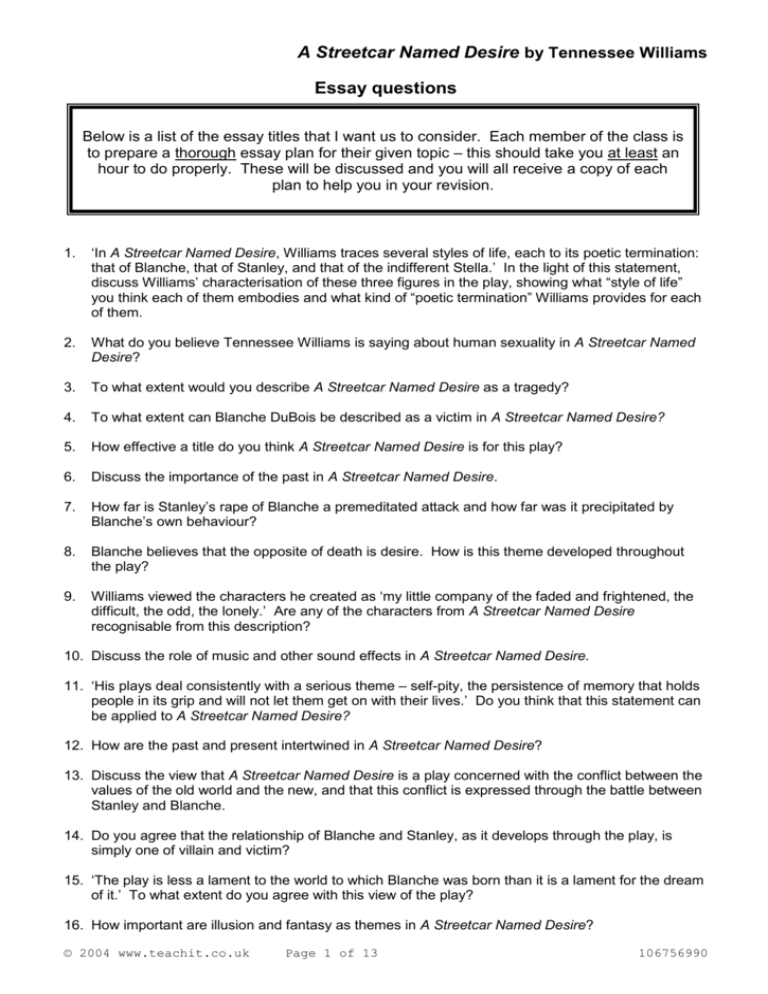
A Streetcar Named Desire by Tennessee Williams Essay questions Below is a list of the essay titles that I want us to consider. Each member of the class is to prepare a thorough essay plan for their given topic – this should take you at least an hour to do properly. These will be discussed and you will all receive a copy of each plan to help you in your revision. 1. ‘In A Streetcar Named Desire, Williams traces several styles of life, each to its poetic termination: that of Blanche, that of Stanley, and that of the indifferent Stella.’ In the light of this statement, discuss Williams’ characterisation of these three figures in the play, showing what “style of life” you think each of them embodies and what kind of “poetic termination” Williams provides for each of them. 2. What do you believe Tennessee Williams is saying about human sexuality in A Streetcar Named Desire? 3. To what extent would you describe A Streetcar Named Desire as a tragedy? 4. To what extent can Blanche DuBois be described as a victim in A Streetcar Named Desire? 5. How effective a title do you think A Streetcar Named Desire is for this play? 6. Discuss the importance of the past in A Streetcar Named Desire. 7. How far is Stanley’s rape of Blanche a premeditated attack and how far was it precipitated by Blanche’s own behaviour? 8. Blanche believes that the opposite of death is desire. How is this theme developed throughout the play? 9. Williams viewed the characters he created as ‘my little company of the faded and frightened, the difficult, the odd, the lonely.’ Are any of the characters from A Streetcar Named Desire recognisable from this description? 10. Discuss the role of music and other sound effects in A Streetcar Named Desire. 11. ‘His plays deal consistently with a serious theme – self-pity, the persistence of memory that holds people in its grip and will not let them get on with their lives.’ Do you think that this statement can be applied to A Streetcar Named Desire? 12. How are the past and present intertwined in A Streetcar Named Desire? 13. Discuss the view that A Streetcar Named Desire is a play concerned with the conflict between the values of the old world and the new, and that this conflict is expressed through the battle between Stanley and Blanche. 14. Do you agree that the relationship of Blanche and Stanley, as it develops through the play, is simply one of villain and victim? 15. ‘The play is less a lament to the world to which Blanche was born than it is a lament for the dream of it.’ To what extent do you agree with this view of the play? 16. How important are illusion and fantasy as themes in A Streetcar Named Desire? © 2004 www.teachit.co.uk Page 1 of 13 106756990 A Streetcar Named Desire by Tennessee Williams AO 5 – Context Context is the dominant assessment objective for this unit so here is some more information to help you to make sure that you are able to incorporate this element into your essays. You are NOT expected to learn it all, merely to use it to add to your understanding of the play. Likewise, huge swathes of contextual information are not necessary in your essays – you just need to show that you have thought about it, understood it and are able to apply the knowledge to the text. This is not exhaustive – feel free to add your own information as you wish. Context of the author: Williams is thought to have been able to identify with a fragility and vulnerability in women and once said: I draw every character out of my very multiple split personality. My heroines always express the climate of my interior world at the time in which those characters were created. He found examples of universal experience in the fringes of acceptable behaviour – maybe this relates to his personal experiences. Dramatic / Theatrical context: Remember to talk about plastic theatre. You should also be able to talk about the version that you saw in Edinburgh (Royal Lyceum Theatre Company; 2002) and the film version. As the Twentieth Century dawned, so too did a distinct Southern Literature. Writers’ fascination with the past began to turn towards the economic decay symbolised by the decaying beauty of the plantations (see Belle Reve). In the 1920s, playwrights were looking at the behaviour of the world and addressing the question “why did this happen?” through their works. Williams asked “what did it feel like to have this happen?” His focus was on the workings of the human psyche. You could look at particular images in the play, for example the meat at the start of the play, or Blanche’s clothes, or bathing or … Historical context: Tennessee Williams was working on Streetcar at the end of WW2 but there is very little mention made of the war. Despite the fact that the events of the war had been cataclysmic, they receive only a brief mention in the play. This is characteristic of all of Tennessee Williams’ plays. That said, many writers at the time were concerned with the idea that, whilst great leaps forward were being made in a variety of spheres, man’s capacity for evil and destruction also continued to grow. In one sense, the journey from desire to death can be linked to this theme. © 2004 www.teachit.co.uk Page 2 of 13 106756990 A Streetcar Named Desire by Tennessee Williams As a Southerner, he was more affected by the events of the American Civil War (1861 – 1865). Following their defeat by the Northern states, the South suffered economically. However, this air of decaying grandeur added to the romantic appeal for many writer including Williams. As time moved on, industrialisation continued in the cities. Whilst the plantations continued to decay, urban growth and capitalism flourished in the cities. Williams was interested in the progress of American history – not only where it had been, but also where it was going and how it would get there. Stanley represents the American Dream that all men are born equal and can succeed equally, whilst Blanche represents the old world, where class and race are still important issues. Williams was homosexual and whilst this is clearly an aspect of his work, it is important to remember that for most his life, homosexuality remained illegal. It was, however, tolerated in some places, such as New Orleans. Cultural and political context: Tennessee Williams saw the South as a broken and damaged place in which the decay was somehow charming. He said: I write out of love for the South … once a way of life that I am just able to remember – not a society based on money … I write about the South because I think the war between romanticism and the hostility to it is very sharp there. Williams is an almost completely non-political writer. More than any other American dramatist, he began to move away from writing about the large political issues to writing about the emotional burdens of everyday life. The tensions in this play come partly from cultural conflict – the worlds of Stanley and Blanche are so opposed that neither can understand the other. Explore the cultural context in the section at the end of scene 4. Look at the stage directions and at how Blanche characterises the sisters’ upbringing. Social context: Women in the Old South had a social and symbolic role, were expected to be passive and chaste. This world could not give Blanche what she needed (see scene 5) and so she tried to marry into the ‘light and culture’, she discovers that there is corruption and deceit behind the façade. All of the Southern writers seemed to have vivid imaginations which were often bizarre and grotesque (Southern Gothic). The roots of this literature lay perhaps in the fact that the writers knew that they were part of a dying culture – where the dashing and romantic were founded on an economy based on injustice and cruelty. Blanche and Stanley are from different worlds where money has different values. Something to think about – if Blanche and Stanley represent different classes and values, where do Williams’ sympathies lie? Are either of the characters fully endorsed? If not, why not? © 2004 www.teachit.co.uk Page 3 of 13 106756990 IMPORTANT QUOTATIONS A Streetcar Named Desire Find quotations from the play (both direct speech and stage directions) that link with the following themes. Scene 1 Scene 2 Scene 3 Scene 4 Fantasy / illusion Cruelty Primitive / primal Desire Loneliness © 2004 www.teachit.co.uk Page 4 of 13 106756990 IMPORTANT QUOTATIONS A Streetcar Named Desire Find quotations from the play (both direct speech and stage directions) that link with the following themes. Scene 5 Scene 6 Scene 7 Scene 8 Fantasy / illusion Cruelty Primitive / primal Desire Loneliness © 2004 www.teachit.co.uk Page 5 of 13 106756990 IMPORTANT QUOTATIONS A Streetcar Named Desire Find quotations from the play (both direct speech and stage directions) that link with the following themes. Scene 9 Scene 10 Scene 11 Fantasy / illusion Cruelty Primitive / primal Desire Loneliness © 2004 www.teachit.co.uk Page 6 of 13 106756990 A Streetcar Named Desire How do the elements of “Plastic Theatre” add to your understanding of the play? Think about those aspects of theatre which Williams himself used in what he called “plastic theatre”. Now that you have seen the play, you should have a greater understanding of the significance of these things. BLUE PIANO VARSOUVIANA LOCOMOTIVE SOUND EFFECTS A Streetcar Named Desire Scene 3 This scene can be divided into 5 stages. Read it through, identify where the stages fall and briefly summarise what happens in each stage. 1) 2) 3) 4) 5) Now look closely at the conversation that Blanche has with Mitch. How does it compare with her conversation with Stanley in Scene 2? You should be able to see that she is using similar tactics to the ones she tried with Stanley earlier on. Why do you think that they are more effective here? Now look closely at the end of the scene when Stanley reacts violently. What are the effects of his actions on: a) the audience b) what impressions about the characters are confirmed or introduced by the end of the scene A Streetcar Named Desire Scene 4 – the morning after the night before… Blanche and Stella react very differently to the events of the previous night. What does this add to your understanding of the two women? List reasons in bullet points then add your personal comments in the larger box. Stella is relaxed, serene, tranquil Blanche had a sleepless night Blanche is determined to make Stella ‘face the facts’ about Stanley. Trace the development of their conversation, looking at how Blanche feels and how Stella responds. Stella p.72/4 – insists that she doesn’t want to get out of anything Blanche p.71 - says Stella is mad to have returned to Stanley; wanted to rush after her A Streetcar Named Desire As the locomotive approaches, Stanley arrives and overhears part of the conversation between the sisters. What does her speech about Stanley add to your understanding of her character? Why do you think that she dislikes him so intensely? Do you sympathise with her? At the end of the scene, as Stanley and Stella embraces, Stanley grins at Blanche. Bearing in mind what he has just overheard, why do you think that he is grinning? Choose 3 – 5 ‘key quotes’ to learn for the exam from this scene and write them below. A Streetcar Named Desire A Streetcar Named Desire - Scenes 10 and 11 Look at the stage directions at the start of scene 10. Blanche’s appearance at the start of the play was ‘incongruous’. What does she look like now? What impression do you get of Stanley’s mood and the reasons for it at the start of this scene? Look carefully at pages 107 – 108, to where Blanche says ‘Let there be no hard feelings…’ How does she bring about his change in mood? How does Williams develop the dramatic tension from page 108 to the end of the scene? Think about: Blanche’s actions: Stanley’s actions: The stage directions: A Streetcar Named Desire The play has been described as “eleven one-act plays” in which each scene could stand alone (exposition → crisis → resolution). Although the scenes could be seen as separate, there is always a sense of the play moving inevitably towards a conclusion. The play builds towards this scene in particular. What is your explanation for Stanley’s final words in the scene – ‘We’ve had this date from the beginning.’ Scene 11 How much of Blanche’s behaviour at the beginning of the scene is characteristic and how much does it reveal the extent of her breakdown? What part do the following characters play in this scene? Stella Stanley Mitch A Streetcar Named Desire Tennessee Williams’ Background to A Streetcar Named Desire From an early age, Williams used writing as “an escape from a world of reality in which [he] felt acutely uncomfortable. He wrote about the human condition as he saw it; unafraid to tackle topics such as incest, rape and madness. He believed that “we are all savages at heart”. Which of the characters in Streetcar prove or disprove this? He lived in New Orleans from 1938, a bohemian place where all manner of behaviour was tolerated, if not encouraged. It was here that he was inspired to create Streetcar. It is said that he saw, on the Vieux Carré, two streetcars. One was named “Desire” and the other “Cemetery” – which he thought was somehow symbolic of life itself. We find, in this play, an implicit condemnation of homosexual behaviour. Was this his attempt to pacify those who disagreed with homosexuality or influenced by the fact that he was a homosexual but extremely uncomfortable with his sexuality? He also has a preoccupation with physical ugliness and the inevitability of death. He suffered a crisis in 1946 when he believed, incorrectly, that he was suffering from incurable cancer. Is this why Blanche is so afraid of the light? His sister Rose suffered a breakdown in 1937 and was admitted to a mental hospital and, not long afterwards, she was lobotomised. Williams suffered from depression throughout his life and lived in fear that he too would go insane. In the mid-twentieth century, Americans were fascinated and charmed by the idea of the South, a place they associated with a landed elite in elegant houses, flaunting their inherited wealth and studied gentility. For Williams, the South stood for strong cultural values whilst the North was greedy and sordid. Thus we can see that Blanche and Stanley are opposites. Williams was influenced not only by American drama, including that of the South, but also by European culture. Like Ibsen and Miller, he increases dramatic tension through revealing to the audience the degree to which the characters’ self image is pretence. The climax comes when the character is forced to confront both the past and the present simultaneously, either acknowledging their actions and dealing with the consequences or retreating further into pretence, even madness.

